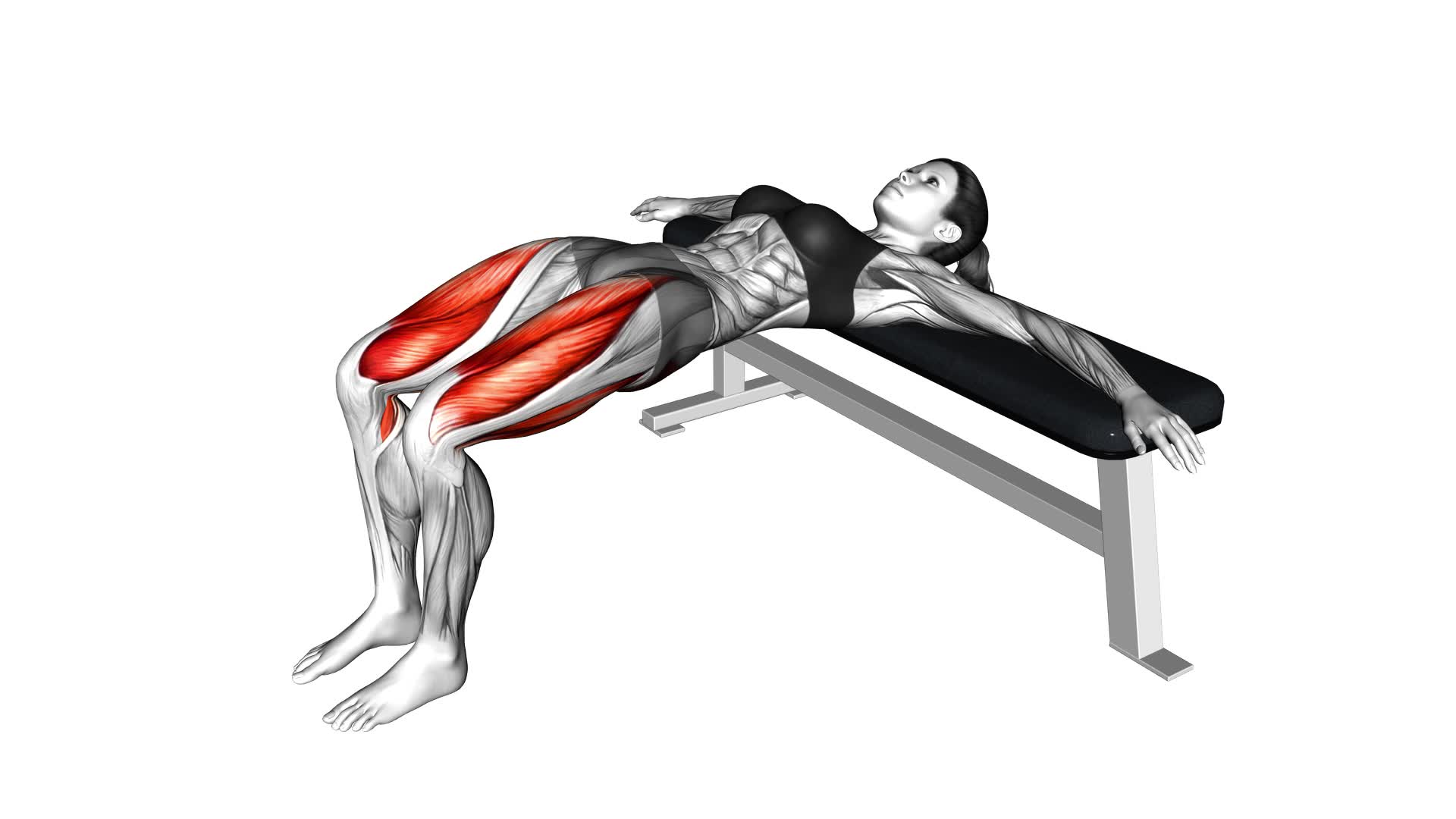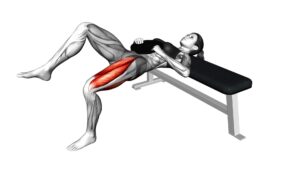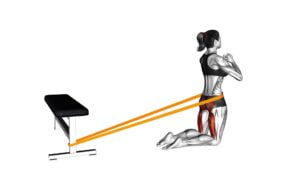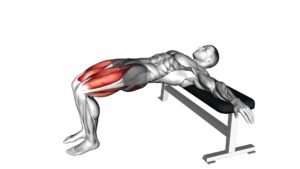Hip Thrusts (Female) – Video Exercise Guide & Tips

Looking to tone and strengthen your glutes? Look no further than hip thrusts!
Watch This Exercise Video
This video exercise guide and tips will walk you through the proper form and technique, as well as variations and progressions to challenge yourself.
Avoid common mistakes and maximize your results with these helpful tips.
Get ready to feel the burn and achieve your fitness goals with hip thrusts.
Let's get started!
Key Takeaways
- Hip thrusts increase glute strength and size.
- Proper form and technique are crucial for maximizing the benefits of hip thrusts.
- Variations and progressions can be used to intensify the exercise and target different muscle groups.
- Consistency and proper nutrition are important for maximizing results from hip thrusts.
Benefits of Hip Thrusts
There are 5 major benefits of incorporating hip thrusts into your exercise routine.
One of the key benefits is glute activation. Hip thrusts specifically target the glute muscles, helping to activate and strengthen them. This is especially important for individuals looking to build stronger glutes or improve their overall lower body strength. By incorporating hip thrusts into your routine, you can effectively engage your glute muscles and promote better muscle activation and development.
Another benefit of hip thrusts is their ability to improve athletic performance. The glute muscles play a crucial role in many athletic movements, such as sprinting, jumping, and changing directions. By strengthening your glutes through hip thrusts, you can enhance your power and explosiveness, leading to improved performance in various sports and physical activities.
Incorporating hip thrusts into your exercise routine can also help improve your posture. Weak glutes can contribute to poor posture, as they're responsible for stabilizing the pelvis and maintaining proper alignment of the spine. By strengthening your glutes through hip thrusts, you can improve your posture and reduce the risk of developing back pain or other postural issues.
Furthermore, hip thrusts are a great exercise for targeting the glute muscles without putting excessive strain on the lower back. Compared to other glute exercises, such as squats or lunges, hip thrusts allow for a more isolated activation of the glutes, minimizing the involvement of other muscle groups. This makes them a safer and more effective exercise for individuals with lower back issues or those looking to specifically target their glutes.
Lastly, hip thrusts can help enhance overall lower body strength and stability. By incorporating this exercise into your routine, you can improve the strength and stability of your hips, which can have a positive impact on your overall lower body strength. This can be beneficial for activities such as running, jumping, or even everyday movements like walking and climbing stairs.
Proper Form and Technique
To perform hip thrusts with proper form and technique, you should consistently engage your glute muscles and maintain a stable pelvic position throughout the exercise. This is crucial for injury prevention and optimal muscle activation.
Start by sitting on the ground with your back against a bench or step, knees bent, and feet flat on the floor. Place a barbell or weight across your hips. Drive through your heels, lifting your hips off the ground while squeezing your glutes. Keep your core engaged and avoid arching your lower back. At the top of the movement, your body should form a straight line from your knees to your shoulders. Slowly lower your hips back down to the starting position.
Remember to breathe throughout the exercise and avoid straining your neck or shoulders. By maintaining proper form and technique, you'll maximize the benefits of hip thrusts and reduce the risk of injury.
Now that you understand the correct way to perform hip thrusts, let's explore some variations and progressions to challenge yourself even further.
Variations and Progressions
Now that you understand the correct way to perform hip thrusts with proper form and technique, you can explore variations and progressions to challenge yourself even further. If you're looking to take your hip thrusts to the next level, there are advanced techniques you can try.
One option is to add resistance by using a barbell or dumbbells placed on your hips. This added weight will increase the intensity of the exercise and help you build even more strength and muscle.
Another advanced technique is the single-leg hip thrust, where you perform the exercise with one leg raised off the ground. This variation targets your glutes and hamstrings more effectively and also challenges your balance and stability.
On the other hand, if you find the standard hip thrust too challenging or if you have any physical limitations, modifications and regressions can be useful.
You can start by using a resistance band around your knees or thighs to activate your glute muscles even more. Alternatively, you can perform the exercise with your feet placed on the floor instead of an elevated surface, making it easier to maintain proper form.
These modifications allow you to gradually progress and build strength until you're able to perform the full hip thrust.
Common Mistakes to Avoid
To ensure you get the most out of your hip thrusts, it's important to be aware of common mistakes to avoid. Here are three common misconceptions about hip thrusts that can hinder your performance:
- Not engaging your glutes: One common mistake isn't properly engaging your glute muscles during the exercise. Many people rely too heavily on their lower back or hamstrings, which can lead to poor form and reduced effectiveness. To improve your hip thrust performance, focus on squeezing your glutes at the top of the movement and maintaining tension throughout.
- Using too much weight: Another mistake is using too much weight too soon. While it's important to challenge yourself, using excessive weight can compromise your form and increase the risk of injury. Start with a weight that allows you to maintain proper technique and gradually increase as your strength improves.
- Neglecting proper form: Proper form is crucial for hip thrusts. A common mistake isn't maintaining a neutral spine and pelvic position. Avoid arching your lower back or hyperextending your hips. Instead, keep your core engaged, maintain a slight pelvic tilt, and focus on a controlled and smooth movement.
Tips for Maximizing Results
To maximize your results, focus on implementing the following tips into your hip thrust routine.
First and foremost, pay attention to your nutrition. Eating a balanced diet that's rich in protein can help support muscle growth and recovery. Include lean sources of protein such as chicken, fish, tofu, and beans in your meals. Additionally, make sure to consume enough calories to fuel your workouts and promote muscle growth.
In terms of equipment, using a barbell is highly recommended for hip thrusts. It allows you to progressively overload the muscles and challenge them as you get stronger. Start with a weight that you can comfortably handle and gradually increase it over time. A barbell pad can also provide extra comfort and reduce discomfort on your hips.
Furthermore, proper form is crucial for maximizing results and minimizing the risk of injury. Ensure that your feet are firmly planted on the ground and your knees are aligned with your toes. Engage your glutes and core muscles as you lift your hips off the ground. Squeeze your glutes at the top of the movement for an extra contraction.
Frequently Asked Questions
Is It Safe to Perform Hip Thrusts During Pregnancy?
Yes, it's important to consider your safety when performing hip thrusts during pregnancy. While hip thrusts can be a great exercise for building glute strength, they may not be recommended for everyone during this time.
It's crucial to consult with your healthcare provider for alternatives or modifications that are safe and comfortable for you. Your provider can provide guidance on exercises that will support your fitness goals while ensuring the health and well-being of both you and your baby.
Can Hip Thrusts Help Improve Posture?
Hip thrusts can be an effective exercise for improving posture. By targeting the glute muscles, hip thrusts help strengthen your core and promote better spinal alignment.
The upward movement of the hips engages the muscles in your lower back, which can help counteract the effects of poor posture.
Incorporating hip thrusts into your workout routine, along with other exercises that target the core and back muscles, can contribute to improved posture over time.
How Often Should I Incorporate Hip Thrusts Into My Workout Routine?
To properly perform hip thrusts and reap the benefits of incorporating them into your routine, you need to know how often to include them.
Consistency is key. Aim for two to three times a week, allowing for rest and recovery in between.
This will help you build strength and muscle in your glutes, hamstrings, and lower back.
Remember to start with proper form and gradually increase intensity to avoid injury and maximize results.
Can Hip Thrusts Help Alleviate Lower Back Pain?
Hip thrusts are a great exercise for glute activation and can potentially help alleviate lower back pain. By engaging your glutes, hip thrusts can help to stabilize and support your lower back, reducing strain and discomfort.
To maximize results, you can incorporate different variations of hip thrusts into your routine. These variations target different angles and muscles, ensuring a well-rounded workout for your glutes and lower back.
Remember to always maintain proper form and consult with a professional if you have any concerns.
Are Hip Thrusts Suitable for Beginners or Should They Be Reserved for Advanced Trainees?
Hip thrusts can be suitable for beginners or advanced trainees. They offer various hip thrust variations that can cater to different fitness levels. Beginners can start with bodyweight hip thrusts and gradually increase resistance.
The benefits of hip thrusts for glute activation make them a valuable exercise for everyone. Incorporating hip thrusts into your workout routine can help strengthen your glutes, improve hip mobility, and enhance overall lower body strength.
Conclusion
In conclusion, hip thrusts are a highly effective exercise for females that target the glutes and improve overall lower body strength.
By using proper form and technique, variations and progressions can be incorporated to continuously challenge and progress in this exercise.
Avoiding common mistakes and following the provided tips will help maximize results.
Incorporating hip thrusts into your workout routine can lead to improved muscle tone, strength, and overall fitness.

Author
Years ago, the spark of my life’s passion ignited in my mind the moment I stepped into the local gym for the first time. The inaugural bead of perspiration, the initial endeavor, the very first surge of endorphins, and a sense of pride that washed over me post-workout marked the beginning of my deep-seated interest in strength sports, fitness, and sports nutrition. This very curiosity blossomed rapidly into a profound fascination, propelling me to earn a Master’s degree in Physical Education from the Academy of Physical Education in Krakow, followed by a Sports Manager diploma from the Jagiellonian University. My journey of growth led me to gain more specialized qualifications, such as being a certified personal trainer with a focus on sports dietetics, a lifeguard, and an instructor for wellness and corrective gymnastics. Theoretical knowledge paired seamlessly with practical experience, reinforcing my belief that the transformation of individuals under my guidance was also a reflection of my personal growth. This belief holds true even today. Each day, I strive to push the boundaries and explore new realms. These realms gently elevate me to greater heights. The unique combination of passion for my field and the continuous quest for growth fuels my drive to break new ground.







